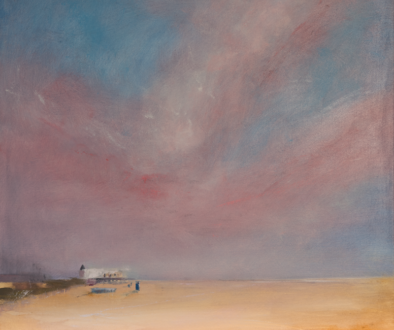Shooting for the Moon

Cape May is a veritable artists’ colony, which is no surprise with the number of subjects and scenery available here. There are many artists of all styles working in various mediums in the area. One such artist shoots for the moon, and it seems she has landed.
As one does in a small town, I heard through the grapevine that Sydnei Smithjordan has new works in progress based on the people of Cape May and that her work is even coming to the silver screen. An award-winning artist, Sydnei has been recognized with honors as the 2005 Astrea Foundation for Justice Honorable Mention for Visual Arts, the 2022 Art Tour International Magazine (ATIM) Artist of The Week, and most recently, the 2023 ATIM Top 60 Masters.
Sydnei talks about the journey that brought her to Cape May. In our conversation, she shared her philosophy, style, and artist’s journey, and she even brought some paintings to share. On each painting, her signature crescent moon with a heart dangling within can be found.
Q: Let’s start by explaining your signature. What does this symbolism mean to you?
A: The moon is endless. To the moon and back! The heart represents my love, my passion. Every painting has this symbol as my signature. Sometimes it’s obvious. Sometimes it’s hidden. Look for it in my paintings. It’s there, but not always so easy to spot.
Q: Congratulations on your recent award! What is it like winning the 2023 ATIM Top 60 Masters award?
A: I was invited earlier this summer to New York City for the awards ceremony at the Museum of Art and Design. It was an immense honor to be among the 60 artists who were recognized for this “Oscars of Visual Arts.” I was recently told that on June 22, 2024, I will be honored again at the 2024 ATIM Top 60 Masters Awards. I am humbled. I’m excited. This honor really raised the bar for me as an artist.
Q: How would you describe your style and medium to someone who has never seen your work?
A: I call my style “pop fusion.” It’s pop art, but it has multi-traditional, multi-genre juxtaposed with various styles. My paintings are primarily oil on canvas.
Q: Where did you learn your craft?
A: I have a Bachelor of Fine Arts, degrees in Illustration, Graphic Design, and Commercial Arts, and a Master of Fine Art, certifications in Medical Illustration, and cosmetic arts…but I taught myself.
Q: That’s a lot. Where do we even start, in terms of your formal training?
A: I was studying at the Santa Monica College of Design Art and Architecture. This was a new experimental school, a branch of Santa Monica College. They wanted to give attention to artists who should be mainstream but couldn’t attend the major art schools, so I applied, went before a panel, and was admitted. There were about 20 of us that first year.
I was doing a lot of what I call “tight work,” illustrations using a very fine Rapidograph pen. My mentor, Ron Davis, loved my work but he stressed that I’d go further if I were willing to move to oil paints on canvas and create larger works. I was provided a studio, canvases, and oil paints, but no instruction. I painted straight out of the tube, and I did well with that.
Eventually, I had a decision to make: Go professional, with an agent, and start my art career, or continue my education. Ron advised me to go the agent route, but I wanted to go to the best school in the world, and for me, it was Rhode Island School of Design (RISD). I landed a full scholarship. Having taught myself, painting straight out of the tube, I didn’t fit in with traditional painting approaches. People don’t just paint straight out of the tube! It’s not a classical method. I failed basic drawing. I couldn’t draw an apple, but I could paint a person. It’s just the way my brain works. Ultimately, I was expelled. This school turns out great artists, and I couldn’t draw an apple. I told them, “You want me to be Van Gogh, but I want to be Sydnei Smithjordan.” They reconsidered and I continued my education there and later graduated.
Q: Talk more about your first professional work in the arts.
A: About 30 years ago, I was living in Los Angeles. It was popular to have a tricked-out skateboard, so I worked making a living doing acrylic airbrush artwork on skateboards, cars, interiors of cars…we tricked out all kinds of things. I made a decent living doing that, but I got to a point where I needed extra money. I had an accident with my truck—I knew that was going to be expensive. At the autobody shop, I met the technician, Gary O’Neil. Gary knew I was an artist, and he made a deal with me. He had a demand for tricked-out car paint jobs, and I needed my truck fixed. I taught him how to paint cars, and he taught me how to fix my truck. He gave me a job painting cars, which led to more opportunities to paint set designs for theaters, rooms in homes, and more.
I eventually moved to Georgia and met up with Jackson Walker, a friend who owned a coffee shop, and an actor. He was in Tyler Perry’s The Great Debaters. This is when it got interesting with art collectors. Jackson asked me to do paintings that he could gift to his actor friends, Denzel Washington, Oprah Winfrey, and Forest Whittaker, resulting in magazine and news articles. But life happens, so I found myself living in Baltimore and teaching for a while at the Maryland Institute College of Art.
Q: Where does “medical illustration” fit into your repertoire?
A: Medical illustration led me to a position where I used this skill to draw medical representations from accident scenes. I would work with police departments and courtrooms. I combined my medical illustration background with a certificate in cosmetics, first for the purpose of helping breast cancer survivors, to help cosmetically enhance the look of a natural breast after breast removal, recreating areolas, and things like that. That evolved into more creative tattooing. It was rewarding on a whole other level, but it was also a way to support myself at the time.
Q: How did you eventually land in Cape May?
A: Family circumstances brought me to Cape May. When I first arrived, I thought, “This is a small town. What am I going to do here? My career is over.” But I started doing my skateboard paintings. People loved them, but I needed to evolve with my work. As a mentor and family member in Cape May, Mark Kulkowitz displayed my skateboards at his restaurant, The Mad Batter. I did a lot of boards in Cape May, and I’ve done three skateboard shows at the Mad Batter.
Mark is also my business partner. He comes up with the ideas, and I execute them.
Q: You didn’t bring any of your skateboards today. Are there any examples of them around town?
A: Yes, there is one at the Kona Board House in Wildwood and one at Nauti Spirits Distillery. There’s one at Uncle Bill’s in North Cape May and one at Villas Vapes. There are local private art collectors who have boards in their collections also.
Q: Let’s talk about these paintings you brought to share with readers. We’ll start with this painting of Harriet Tubman.
A: I did a series of Harriet Tubman paintings, in 2019, due to her connection to Cape May, and some of these images were used to promote the Harriet Tubman Museum. I created a series of about 30 pieces, illustrating her life from beginning to end. Shortly after these were painted, I did a show at the Ocean City Art Museum entitled “Death or Liberty.”
This Harriet Tubman painting is actually a depiction of Cecily Tyson as Harriet Tubman, in the film A Woman Called Moses. It’s in my personal collection.
Mark Kulkowitz knew I wanted to do more with my artwork, so he commissioned me to do a series of paintings of the Cape May Giants Negro League. We looked at photographs of this team. The manager’s granddaughter lives here, and she places the timeframe at around 1923. There’s a photograph where you can see her father, who was the bat boy. Mark commissioned the piece, and from there, the official Cape May Negro League Society was started. Once this was complete, it wasn’t over. Mark’s a dreamer and he loves baseball—even though he’s a Mets fan, but I forgive him for that [laughs]. He commissioned me to do a series on the Negro League. The Negro League was underserved black men and women who just wanted to play ball.




Q: That’s a great segue into the paintings from the Negro League baseball series that you brought with you.
A: Willie is a portrait of Willie Mays. This one was part of the Negro League series and is in my personal collection. Willie Mays is almost 90 now. This is the celebration piece depicting Willie as he experiences the sensation of Gatorade being poured over his head.
Jackie
This is Jackie Robinson. There is not a lot to say about this. Everyone knows Jackie. He’s the face of integrated baseball. Number 42!
Cooperstown
Dick Allen is depicted in this painting at the Baseball Hall of Fame, and he’s looking at the wall, looking for his name, and it’s not there. When they tried to get him in, a few years back, he was three votes shy, still. He died during COVID. He’s still not on that wall.
Ronnie Lott
A friend of Mark’s, Gaylin White, an author, commissioned a painting of Ronnie Lott. In 2023 I painted Ronnie Lott, Orlando Thomas, and Jackie Robinson. Although Ronnie Lott was a football player, he still had that magic number “42.” This painting made it into White’s book, Coach of a Lifetime. It’s in Chapter 17.
Q: You brought a couple of paintings of female baseball players. Tell us about these.
A: Yes. Throw Like a Girl was a series to recognize the under-celebrated female baseball players over the years. This show appeared at the Noyes Museum in Atlantic City for Women’s History Month, 2023, with 25 paintings and two skateboards. This project was all about sexism and women in baseball.
Alta Weiss
Alta Weiss in the long skirt was a female baseball player in 1836. She played for two years. Back in those days, they didn’t have women’s baseball, but they let women play once their housework was complete. Weiss later went on to become a doctor. Toni Stone was the first black female to play for a men’s team. She played for the Indianapolis Clowns. They were the only team that really had all three of the women who played Negro League ball. Toni Stone, then Connie Morgan, and Mamie “Peanut” Johnson. Notice how long Alta’s dress is? Later, women were made to wear short dresses in baseball, an objectifying way to sell tickets.
Sliding Into First
Women now wear the same uniform as men. They’re safer. This image doesn’t represent a specific player, but rather a general representation of modern women in baseball.
Q: What project came next?
A: The Cape May Veterans Project. Besides baseball, this is Mark’s other love. Again, his idea, my execution. Cape May Heroes was one of my biggest honors. It’s a series depicting local veterans. The Wildwood Naval Air Station has two Tuskegee paintings in its collection. The art shows there were on Memorial Day weekend and another Labor Day weekend in 2023.

Q: There is a photograph floating around of you with Whoopi Goldberg. Do tell!
A: Yes! I went to Patterson, New Jersey, for the reopening of Hinchliffe Stadium. This stadium hosted the Negro League. It was recently renovated, and at the grand re-opening, I met Whoopi Goldberg where I presented the painting, a gift to Goldberg from Paterson’s mayor. It depicts the three women of Negro League Baseball: Toni Stone, Connie Morgan, and Mamie “Peanut” Johnson.
Ironically, as a student at Santa Monica College long ago, I sent a painting of Whoopi to her, through her publicist. I never heard anything after that. Still, this was actually the second time I presented a painting to her. I was starstruck! Before I got home after that event, Whoopi reached out to me. She found my website and purchased The Embrace, depicting Jackie Robinson and Pee Wee Reese. Plus, she commissioned me to do a personalized piece, in progress.
Q: You must be pinching yourself. What else are you working on?
A: I’m currently creating a series for the Perkins Art Center in Collingswood in January 2024 of 40 30×30” pieces called “Misfits and Weirdos.” I’m snooping on people in Cape May, regular people, doing what they do, being themselves. Aren’t we all just a bunch of misfits and weirdos? And I mean this affectionately. It’s a story of the people, the ones who are the reason that I love it here. I have already posted a few of them on social media.
I am also working on a large project for Hinchliffe Stadium. I was commissioned to do work for the locker room, hallway, and museum to include approximately 40 to 60 30×30” wood panel pieces.
Q: That’s going to keep you busy. Is anything coming up beyond that?
A: In the very near future, my work will be appearing on the big screen. There are about six large pieces that you can look forward to seeing in a major film. That’s all I can say about that for now.
Q: I’m intrigued! Are you “going Hollywood” now?
A: No. Cape May is my home. I’ve gotten so much support and have so many friends here. I grew up in an orphanage, and you don’t just leave friends and family like the ones I have here. I’m not going anywhere.
Q: Good! One last thing: What advice would you give any artist just getting started?
A: Keep at it. It’s not an easy life, but if you stay true to your craft, it’s worth it. Keep learning and creating art.



